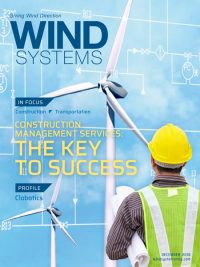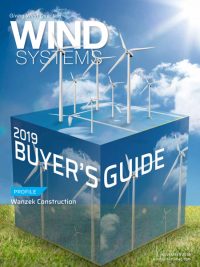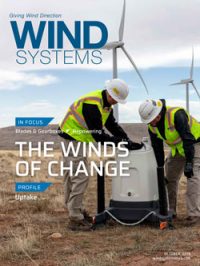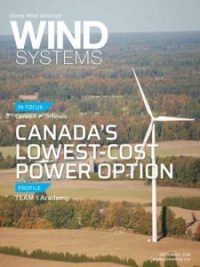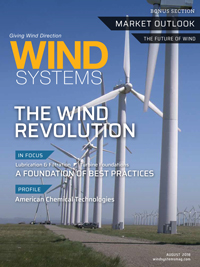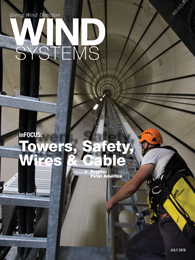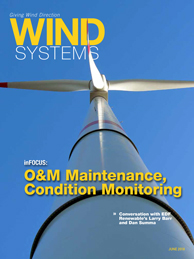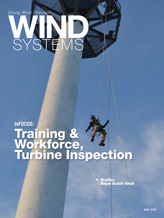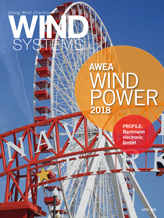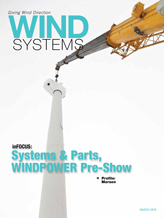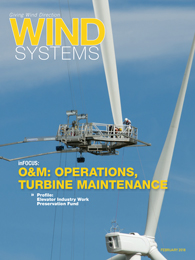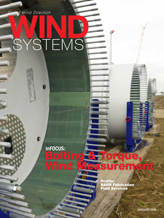December 2018
The path to American offshore wind
Proven vessel concepts adapted based on operator preferences are critical to taking the risk out of U.S. offshore wind.
Advancing offshore construction
The floating wind turbine sector requires advancement in the development of foundations and mooring systems.
Construction management services: The key to success
Beyond safety, each step of the way during the construction of a wind farm, there needs to be checks and balances to ensure the project remains on track.
October 2018
The Winds of Change
Assessing the profitability of a repowering project
The Rise in Capacity Factor
Larger blades optimized for low-wind class siting support the trend of driving up turbine capacity factor.
Main shaft bearing lubrication
Main shaft bearings are a critical component in the driveline of a wind turbine, and selection of the right lubricating grease is essential in the prevention of premature bearing damage.
September 2018
The Case for a Jones Act WTIV
Wind turbine installation vessels (WTIVs) will allow for faster and more efficient offshore construction.
Canada’s lowest-cost power option
As Canada moves toward a low-carbon energy future, economical wind energy will be indispensable for meeting climate commitments
August 2018
STATE SPOTLIGHT: Wyoming – Harnessing wind’s potential
Wind power is on the verge of turning Wyoming into a major player in the field of renewable energy.
MARKET OUTLOOK: Balancing advancements and risk
While there are still a number of risks for project owners to consider, what’s clear is that renewables projects are seemingly trending toward more advanced technologies at lower costs.
MARKET OUTLOOK: East Coast Offshore Wind Outlook
When it comes to the offshore wind industry, progress is being made with a regional approach.
MARKET OUTLOOK: The Wind Revolution
Forecasts and trends show American wind power is on track to supply 10 percent of the country’s electricity by 2020.
Significant energy benefits
Sine pumps optimize high viscosity resin delivery for Enercon, one of the world’s largest wind turbine manufacturers.
A Foundation of best practices
Understanding what to look for today can save millions tomorrow when it comes to inspections and maintenance of turbine foundations.
July 2018
Innovations in current transducers
Smaller, more efficient, more accurate sensors can be used for a variety of wind-turbine applications.
Aspects of wind safety
Wind technicians should be properly trained for any possible emergency scenario, so they know what to do if the need arises.
The mysterious met tower
Met-tower maintenance is an often-overlooked necessity in order to keep a wind farm functioning properly.
June 2018
Boosting operating efficiency
Predictive maintenance based on vibration monitoring can raise the efficiency of wind turbines by preventing catastrophic failure and unscheduled downtime.
Tackling turbine security
Turbine hardware and software aren’t made in a bubble, which sparks the need to tackle security vulnerabilities.
Protecting critical equipment
How tribology can help extend machinery service life.
May 2018
Skill is just the beginning
Iowa Lakes Community College teaches its future wind technicians more than just how to repair turbines.
Competency-based training
The Wind Turbine Technician Academy at Kalamazoo Valley Community College teaches master skills that are highly sought after in the wind-energy industry.
Rising Costs of Wind O&M and the Importance of the Human Factor
Advanced mobile and cloud-information technology can be a potent tool in helping wind technicians and their managers get better results.
April 2018
Cheaper Wind Equals More Wind
As wind power becomes more affordable and cost effective, its reach across the U.S. widens — 41 states are now home to utility-scale wind farms.
Cheaper Wind Equals More Wind
As wind power becomes more affordable and cost effective, its reach across the U.S. widens — 41 states are now home to utility-scale wind farms.
The World of Turbine Bearings
Recent technological innovations show how far bearings have evolved in meeting operational demands and improving productivity and profitability.
The Business Value of Digitalization
It goes beyond creating a digital model of a turbine for operations and maintenance.
March 2018
Verifying remote sensing devices
DNV GL and Group NIRE establish new verification site for RSDs.
Priming the grid for green
Moving from 30 to 3,000 MWs offshore wind means rethinking the transmission grid.
Improving the friction power of gears and bearings
Proper lubrication can extend the overall contact fatigue life of gearboxes by a factor of 3.3.
Small component, big reliability
Fiber optic rotary joints are being considered more and more as a replacement for conventional precious metal contacts in wind turbines.
February 2018
Extending the life of wind-turbine components
Specialized PVD coatings, nitriding increase the durability and lifespan of turbine components.
Monitoring wind in cold climates
The ability to keep track of potential ice build up on turbine blades can significantly reduce maintenance costs.
Changing Turbine Gearbox Oil
Technology automatically changes oil in a fraction of the time it would take with traditional methods.
Torque loading: Standards have limits
Part 2: Specific industry standards for wind-turbine drivetrains include gear-failure modes.
January 2018
The Role Of Lidar In Offshore Wind Measurement
Insights into the rise of Lidar as the primary measurement system used in the offshore industry.
Torque Loading: Standards Have Limits
Part 1: How drivetrain loads are important in analyzing component performance.
The Critical Component For Torque Equipment? ISO 17025
From OEMs to tower installers to service contractors, any group that uses torque equipment should be using ISO 17025 calibrated equipment
















